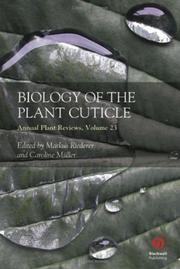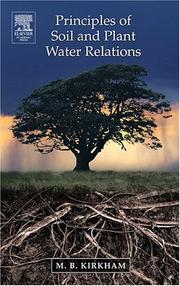| Listing 1 - 10 of 14 | << page >> |
Sort by
|
Book
ISBN: 0713128682 Year: 1983 Publisher: London Arnold
Abstract | Keywords | Export | Availability | Bookmark
 Loading...
Loading...Choose an application
- Reference Manager
- EndNote
- RefWorks (Direct export to RefWorks)
Stomata --- 581.821.1 --- 581.18 --- Leaves --- Stomata. Cuticle --- Movements. Sensibility --- Anatomy --- Plant and Crop Sciences. Botany --- Plant Physiology --- Stomata. --- Plant Physiology. --- 581.18 Movements. Sensibility
Book
ISBN: 0582034833 Year: 1990 Publisher: Harlow Longman
Abstract | Keywords | Export | Availability | Bookmark
 Loading...
Loading...Choose an application
- Reference Manager
- EndNote
- RefWorks (Direct export to RefWorks)
Biological techniques --- Phytomorphology. Phytoanatomy --- Stomata --- Research --- Methodology --- Physiologie végétale --- Plant physiology --- Plante --- plants --- Stomate --- Méthodologie --- methodology --- Expérimentation --- experimentation --- Gravimétrie --- Gravimetry --- Methodology. --- stomata --- experimentation.

ISBN: 140513268X 9781405132688 Year: 2006 Publisher: Oxford Blackwell
Abstract | Keywords | Export | Availability | Bookmark
 Loading...
Loading...Choose an application
- Reference Manager
- EndNote
- RefWorks (Direct export to RefWorks)
Plant cuticle. --- Plant cuticle --- 581.821.1 --- Cuticle --- Plant cells and tissues --- Stomata. Cuticle
Book
Abstract | Keywords | Export | Availability | Bookmark
 Loading...
Loading...Choose an application
- Reference Manager
- EndNote
- RefWorks (Direct export to RefWorks)
Plants are made up of a large number of distinct cell types that originate from a single fertilized egg cell. How the diversity of cell types arise in appropriate places is one of the most fascinating and attractive research areas of plant biology. During the past several decades, due to the development of new molecular techniques and tools, advances in optical microscopy, and availability of whole genome information and mutants in the model plant Arabidopsis and other plants, great advances have been made in understanding the mechanisms involved in cell fate determination in plants. Multiple mechanisms are used to generate cellular diversity. Asymmetric cell division is one of the primary mechanisms. As an example, asymmetric cell division enables one stem cell to generate a stem cell daughter and a daughter with a distinct identity. Initially equivalent cells can also differentiate to generate different cell types. This mechanism has been clearly demonstrated in the formation of multiple cell types during epidermis development in the shoot and root. Cell fate determination is influenced by both intrinsic factors, i.e, developmental regulators, as well as extrinsic signals, i.e., environmental stimuli. By using model systems like stomata, trichome, root hair and shoot and root apical meristem cells, ligands, receptors and transcription factors have been found to regulate cell fate determination. However, the details of signaling cassettes responsible for cell fate determination remain largely unknown. Plants are made up of a large number of distinct cell types that originate from a single fertilized egg cell. How the diversity of cell types arise in appropriate places is one of the most fascinating and attractive research areas of plant biology. During the past several decades, due to the development of new molecular techniques and tools, advances in optical microscopy, and availability of whole genome information and mutants in the model plant Arabidopsis and other plants, great advances have been made in understanding the mechanisms involved in cell fate determination in plants. This research topic contains 12 collected articles, including 2 Opinion Articles, 5 Reviews, 4 Mini Reviews, and 1 Original Research Article. Hopefully, these articles will expand our understanding of the regulation of cell fate determination in plants.
Cotton Fiber --- transcription factor --- stomata --- Xylem --- protein lipid modification --- root hair --- Arabidopsis --- cell fate determination --- Populus --- Trichome
Dissertation
Abstract | Keywords | Export | Availability | Bookmark
 Loading...
Loading...Choose an application
- Reference Manager
- EndNote
- RefWorks (Direct export to RefWorks)
Theses --- Sulphur dioxide --- Vicia faba --- Expérimentation --- experimentation --- Photosynthesis --- Models --- Respiration --- Stomata --- leaves --- symptoms --- Growth period --- Yields --- air pollution --- experimentation. --- Ph intracellulaire
Book
ISBN: 9067541397 Year: 1988 Publisher: Wageningen Wageningen agricultural university
Abstract | Keywords | Export | Availability | Bookmark
 Loading...
Loading...Choose an application
- Reference Manager
- EndNote
- RefWorks (Direct export to RefWorks)
Morphogénèse --- Morphogenesis --- Tissu vasculaire --- Vascular tissues --- Stomate --- Stomata --- Greffage --- Grafting --- Régénération --- Regeneration --- Greffon --- Scions --- Cambium --- Transpiration --- Compatibilité de greffe --- Graft compatibility --- 581.824 --- $?$89/3 --- Regeneration.
Book
ISBN: 0713122102 9780713122107 Year: 1976 Publisher: London Arnold
Abstract | Keywords | Export | Availability | Bookmark
 Loading...
Loading...Choose an application
- Reference Manager
- EndNote
- RefWorks (Direct export to RefWorks)
Plant-water relationships. --- Plants, Motion of fluids in. --- plants --- water --- Water resources --- Stomata --- Transpiration --- Movement --- Eau --- Physiologie végétale --- Plants --- Water --- Metabolism. --- metabolism. --- Physiologie végétale
Dissertation
Abstract | Keywords | Export | Availability | Bookmark
 Loading...
Loading...Choose an application
- Reference Manager
- EndNote
- RefWorks (Direct export to RefWorks)
Citrus --- Culture irriguée --- Irrigated farming --- Réponse de la plante --- Plant response --- Stomate --- Stomata --- Transport des substances nutritives --- Nutrient transport --- Facteur de rendement --- Yield factors --- Zimbabwe --- Sciences and engineering --- biological sciences --- agriculture --- general --- biology --- plant physiology --- 631.67 <689.4> --- 634.3 --- 581.821.1 --- Irrigation--Zambia. Noord-Rhodesië --- Rutaceous and moraceous fruits. Citrous fruits in general --- Stomata. Cuticle --- Theses --- 634.3 Rutaceous and moraceous fruits. Citrous fruits in general --- 631.67 <689.4> Irrigation--Zambia. Noord-Rhodesië --- general. --- plant physiology. --- Oranges --- Irrigation --- Conductivity --- Water --- Conduction --- Oscillations --- Biological sciences --- Agriculture --- General. --- Biology --- Plant physiology.
Book
ISBN: 0582446325 9780582446328 Year: 1983 Publisher: London Longman
Abstract | Keywords | Export | Availability | Bookmark
 Loading...
Loading...Choose an application
- Reference Manager
- EndNote
- RefWorks (Direct export to RefWorks)
Phytomorphology. Phytoanatomy --- Plant physiology. Plant biophysics --- Stomata --- 581.49 --- Other organs. Surface appendages. Stipules. Ochreae. Ligules. Hairs. Prickles etc. --- 581.49 Other organs. Surface appendages. Stipules. Ochreae. Ligules. Hairs. Prickles etc. --- Leaves --- Other organs. Surface appendages. Stipules. Ochreae. Ligules. Hairs. Prickles etc --- Anatomy

ISBN: 128100541X 9786611005412 0080492169 9780080492162 9780124097513 0124097510 9781281005410 0124097510 Year: 2005 Publisher: Amsterdam ; New York : Elsevier Academic Press,
Abstract | Keywords | Export | Availability | Bookmark
 Loading...
Loading...Choose an application
- Reference Manager
- EndNote
- RefWorks (Direct export to RefWorks)
Principles of Soil and Plant Water Relations combines biology and physics to show how water moves through the soil-plant-atmosphere continuum. This text explores the instrumentation and the methods used to measure the status of water in soil and plants. Principles are clearly presented with the aid of diagrams, anatomical figures, and images of instrumentation. The methods on instrumentation can be used by researchers, consultants, and the military to monitor soil degradation, including measurements of soil compaction, repellency, oxygen diffusion rate, and unsaturated hydraulic conduc
Plant-water relationships. --- Plant-soil relationships. --- Groundwater flow. --- Plants and water --- Water and plants --- Water-plant relationships --- Flow, Groundwater --- Plants and soil --- Soil-plant relationships --- Soils and plants --- Soil moisture --- Hydraulics --- Fluids --- Subsurface drainage --- Plant ecology --- Migration --- Hydrodynamics --- Soil water --- Soil water content --- Soil water movement --- Air water interface --- water circulation --- Plant water relations --- Soil water retention --- Translocation --- Water potential --- Stomata --- Transpiration --- Plant-water relationships --- Plant-soil relationships --- Groundwater flow
| Listing 1 - 10 of 14 | << page >> |
Sort by
|

 Search
Search Feedback
Feedback About UniCat
About UniCat  Help
Help News
News